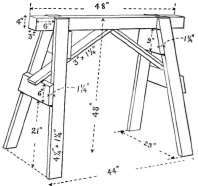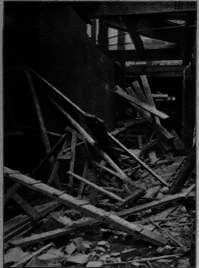42. Outrigger Scaffolds
Description
This section is from the "Safety In Building Construction" book, by The Travelers Insurance Company Hartford, Connecticut. Also see Amazon: Safety In Building Construction.
42. Outrigger Scaffolds
In scaffolds of this kind the characteristic and essential feature is the support of the platform by outwardly-projecting beams (called "thrust-outs," "outriggers," "jibs," "cantilevers," "bearers," and various other names), that are supported in some safe way, - preferably by framework and bracing, inside of the building. The platform is either laid directly upon the thrust-outs, or supported from them immediately and without the intervention of any considerable space or sustaining mechanism. (The suspended scaffolds described in the previous section are not usually classed as outrigger scaffolds, because although they are supported by beams that are thrust out from the building, they are of such a special design that they constitute a class by themselves).
The sustaining beams of an outrigger scaffold should always project entirely through openings in the wall, or through windows, and be solidly and properly supported and braced on the inside of the building. External struts and braces should be used whenever they may be needed to provide additional strength and stiffness.
The thrust-outs should be rigidly held, so that no-displacement of them will be possible, in any direction. They should be of the best material obtainable, and should be strong enough, when considered as beams supported at one end, to sustain, with a factor of safety of at least ten, the heaviest load to which they will be subjected.
43. Horse Scaffolds
These are used for many purposes, both in demolition and in construction work. They should always be of substantial construction, and should rest upon a firm and level foundation. They should never be erected so that they rest upon beams alone, but should always stand upon solid floors. If the permanent floor-covering has not been installed, a temporary layer of planks should be placed upon the beams to support the horses. Sound, strong material should be used when extending the legs of horse scaffolds. The work should be carefully done, and the legs should be braced near the joints to stiffen them. It is always far better, however, to use horses of special construction, rather than to extend the legs of existing ones for the purpose of attaining the necessary height.
Piles of brick, stone, or other loose material should never be used by the workmen in place of scaffolds or platforms, nor should scaffolds, platforms, or horses rest upon such piles, or be supported by them.
All horses should be solid in construction, and of good design. {See Fig. 67.) They should be made of sound, selected material, and should be braced internally so as to be rigid enough not only to carry their normal vertical load with safety, but also to resist deformation from sidewise thrusts. Horses, the parts of which have become loosened or weakened in any way whatsoever, should not be used until they have been repaired in a thorough and workmanlike manner; and extensive repairs should not be undertaken, because it is much better to discard a horse altogether, and replace it with a new and sound one, than it is to spend an unreasonable amount of time in patching up one that is old and weakened.

Fig. 66. A Dangerous Method of Supporting a Horse Scaffold.
Horse scaffolds are less suitable for exterior work than for operations inside of buildings. Many contractors, however, use them for outside work, and sometimes build them up to a height of six or eight tiers. We strongly recommend some other form of scaffold in cases like this, because the horse scaffold is by nature less solid and stable than other types that can easily be had. If it is used in such cases, it should be constructed with great care, and on all scaffolds more than two tiers high the legs of the horses should be nailed down sufficiently to prevent any horse from shifting as the result of wind pressure, the thrust of ladders, the accumulated effect of repeated small motions, or other causes.

Fig. 67. A Well-designed Horse.

Fig. 68. Remains of a Horse Scaffold, after it had BEEN Fouled by a Hoisting Cable.
44. Riveters' Scaffolds
The scaffolds used by riveters are moved about so frequently that it is hardly feasible to safeguard them as completely as other types. Guard-rails should be provided whenever practicable, however, and every other precaution should be taken to avoid accidents. Only sound, strong planks should be used for the platforms, and they should be laid so that they cannot tip or slide. Special care should be exercised in selecting the needle-beams for scaffolds of this kind, and they should be inspected frequently to make sure that they are in good condition.
When it is necessary to use a scaffold of this nature in such a position that one needle-beam is considerably higher than the other one, the planks should be provided with cleats to insure a good foot-hold for the men, and each plank should also be pierced, about one foot from each end, with a hole about 5/8 of an inch in diameter, through which a loosely-fitting bolt should be passed. These bolts should be provided with nuts so they cannot drop out when the planks are turned over, and in laying the platform of the scaffold the bolts should come outside of the needle-beams in all cases.
Continue to:


